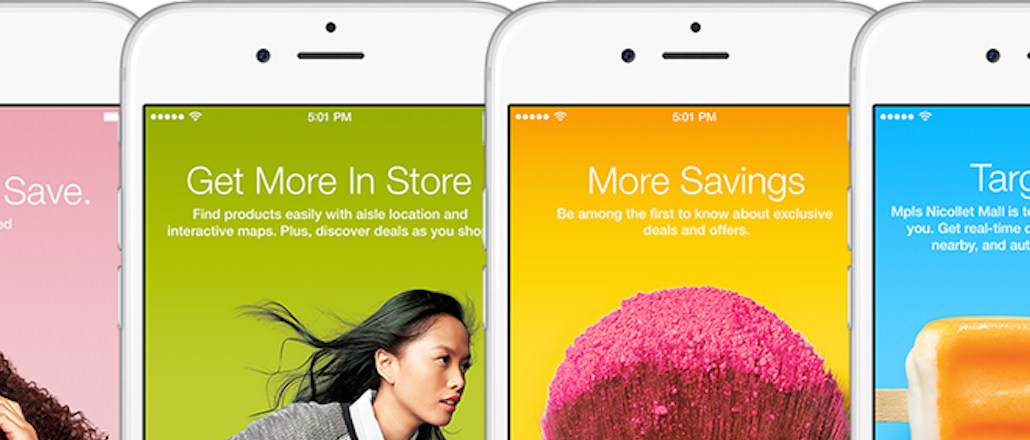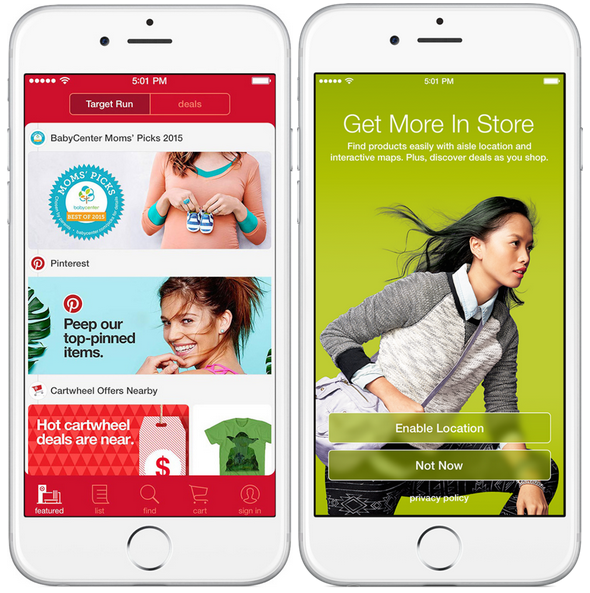Save 50% on a 3-month Digiday+ membership. Ends Dec 5.

Target is making a move to infuse its massive retail stores with the perks of online shopping: The company announced it is introducing beacon technology and push notifications to stores, starting with 50 locations.
It’s a modest initial roll-out but one the retail industry should pay attention to. Target is joining others — like Simon Mall, Macy’s and Lord & Taylor — that have implemented beacons to combine the intelligence of online shopping with the tangibility of physical retail.
“The way we want to leverage this technology in physical stores is by adding the elements that you typically find while online shopping — personal recommendations, for instance — to an in-store experience,” Target rep Eddie Baeb said. “We really want to make sure that the content will add value, and we’ll find out in this early testing phase what guests are responding to.”
If Target, with its broad reach and loyal fan base, successfully implements a beacon experience that customers are wanting to participate in, it could pave the way for other companies to follow suit.
“Target has recognized what a brand needs to do: mimic mobile and online behavior in the retail store. If they get this right, it could be a really great model for the future of the industry,” said Leesa Wytock, director of digital activation at branding firm Siegel+Gale, which doesn’t work with Target.
The company has made clear that it is serious about in-store beacons and location services: Baeb said that the team plans to adapt its learnings from the 50-store roll-out as quickly as possible in order to expand the technology more broadly before the end of the year. Already, Target’s initial launch shows that the company has made an effort to create a more enhanced beacon experience than what’s currently available.
Target’s beacon strategy is very light on push notifications that offer up 10-percent-off coupons and chirp about promotions — the physical world equivalent of spam. (While the company didn’t disclose who’s supplying the beacon hardware, TechCrunch reported it’s coming from Estimote.) Any consumer who opts in to the experience through the Target mobile app (which is the only way to access the store’s beacon features) will be limited to two push notifications per visit. Baeb called the experience “more pull than push.”
Ad position: web_incontent_pos1
Instead, it is focusing on optimizing the location data provided by beacons. Once in the store, the opted-in shopper’s Target mobile app homepage will enable “Target Run,” a feed of announcements and information that will change depending on where you are in the store. Items in certain sections will be suggested based on how well-reviewed they are online or how often they’re pinned on Pinterest. The more the app learns about you, the more personalized the suggestions will be.

Target’s big stores will also become more easily navigable: in-store maps can guide shoppers to find the next item on their in-app shopping list; a confused customer can beckon a Target employee to exactly where they’re standing for help.
“For beacons, the technology and the infrastructure is there. Now, it’s figuring it out from a consumer perspective,” said Kai Tier, group technical director of experiential at R/GA, which doesn’t work with Target. “Basically, that means allowing two-way communication between the company and the customers, not one way.”
For Target, the customer who will test its beacon technology is also its most valuable. Target doesn’t disclose the number of people who actively use its mobile app, but in the Apple Store, it’s one of the most downloaded retail apps. Baeb also said that customers who regularly shop both online and in-store tend to spend three times as much overall than customers who only shop in-store.
Ad position: web_incontent_pos2
“These are the customers who actively want to engage with Target,” said Wytock. “They have a great brand affinity for Target, and the thing that comes with really high brand affinity is high expectation. In this roll-out, they’ll have to listen to consumers, learn from their behavior and adapt accordingly.”
Wytock added that because the customer has a loyalty to the Target brand, those who opt in will be most likely to stick with testing the beacon, even if there are a few initial bugs. This is important: according to Jeremy Sigel, mobile lead at Essence, a single push notification misfire can cause a consumer to permanently opt out.
While there will be high expectations for Target’s beacon program, Wytock believes there will be a measure of patience for the brand to get it right. She said that as long as Target is quick to respond to any complaints about the experience, the consumers will feel as if they’re part of a new experiment to enhance shopping at Target.
On Target’s end, they’re not taking the implementation lightly.
“It’s a huge moment when you can get a new digital product into the physical space,” Baeb said. “It’s very early days for this technology, but we’re willing to make it work for both the digitally savvy consumer as well as the one who isn’t yet.”
More in Marketing

Ulta, Best Buy and Adidas dominate AI holiday shopping mentions
The brands that are seeing the biggest boost from this shift in consumer behavior are some of the biggest retailers.

U.K. retailer Boots leads brand efforts to invest in ad creative’s data layer
For media dollars to make an impact, brands need ad creative that actually hits. More CMOs are investing in pre- and post-flight measurement.

‘AI is permeating everything we do’: How Guitar Center developed 2 AI tools this year
This summer, the company launched a chatbot called Rig Advisor to help customers find the right instruments and products.
Ad position: web_bfu